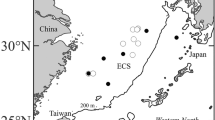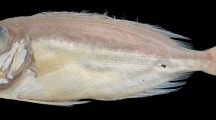Abstract
Gobioid larvae collected from the coast of Okinawa Island, southern Japan, were identified on the basis of a combination of morphological characters and a sequence of a hypervariable region of mitochondrial 12S ribosomal RNA (12S rRNA) gene (138–145 base pairs). A short-term formalin fixation technique enabled identification using both morphological and genetic methods. Thirteen of the 21 types of gobioid larvae assessed were identified to the species level. Additionally, we described the morphology of the postflexion larvae of wormfish Paragunnellichthys sp. and shrimp-associated goby Ctenogobiops feroculus, identified for the first time in their respective genera.



Similar content being viewed by others
References
Akihito, Sakamoto K, Ikeda Y, Aizawa M (2013) Gobioidei. In: Nakabo T (ed) Fishes of Japan with pictorial keys to the species, 3rd edition. Tokai University Press, Hadano, pp 1347–1608, 2109–2211
Borges R, Faria C, Gil F, Gonçalves EJ (2011) Early development of gobies. In: Patzner R, Van Tassell JL, Kovacic M, Kapoor BG (eds) The biology of gobies. CRC Press, Boca Raton, USA, pp 403–464
Baldwin CC, Mounts JH, Smith DG, Weigt LA (2009) Genetic identification and color descriptions of early life-history stages of Belizean Phaetoptyx and Astrapogon (Teleostei: Apogonidae) with comments on identification of adult Phaetoptyx. Zootaxa:1–22
Chakraborty A, Sakai M, Iwatsuki Y (2006) Museum fish specimens and molecular taxonomy: A comparative study on DNA extraction protocols and preservation techniques. J Appl Ichthyol 22:160–166
Clarke TA (1991) Larvae of nearshore fishes in oceanic waters near Oahu, Hawaii. NOAA, Tech Report NMFS 101:1–19
Cunningham MK, Granberry WF Jr, Pope KL (2000) Shrinkage of inland silverside larvae preserved in ethanol and formalin. N Am J Fish Manage 20:816–818
Dawson CE (1967) Paragunnellichthys seychellensis, a new genus and species of gobioid fish (Microdesmidae) from the Western Indian Ocean. Proc Biol Soc Wash 80:73–82
Díaz-Viloria N, Sánchez-Velasco L, Pérez-Enríquez R (2005) Inhibition of DNA amplification in marine fish larvae preserved in formalin. J Plankton Res 27:787–792
Harada S, Suharti SR (2000) Gobiidae. In: Matsuura K, Sumadhiharga OK, Tsukamoto K (eds) Field guide to Lombok Island: identification guide to marine organisms in seagrass beds of Lombok Island, Indonesia. Ocean Research Institute, University of Tokyo, Tokyo, pp 352–369
Hykin SM, Bi K, McGuire JA (2015) Fixing formalin: a method to recover genomic-scale DNA sequence data from formalin-fixed museum specimens using high-throughput sequencing. PLoS One 10:e0141579
Isari S, Pearman JK, Casas L, Michell CT, Curdia J, Berumen ML, Irigoien X (2017) Exploring the larval fish community of the central Red Sea with an integrated morphological and molecular approach. PLoS One 12:e0182503
Karplus I, Thompson AR (2011) The partnership between gobiid fishes and burrowing alpheid shrimps. In: Patzner R, Van Tassell JL, Kovacic M, Kapoor BG (eds) The Biology of Gobies. CRC Press, Boca Raton, USA, pp 559–607
Kawakami T, Aoyama J, Tsukamoto K (2010) Morphology of pelagic fish eggs identified using mitochondrial DNA and their distribution in waters west of the Mariana Islands. Environ Biol Fishes 87:221–235
Kimmerling N, Zuqert O, Amitai G, Gurevich T, Armoza-Zvuloni R, Kolesnikov I, Berenshtein I, Melamed S, Gilad S, Benjamin S, Rivlin A, Ohavia M, Paris CB, Holzman R, Kiflawi M, Sorek R (2018) Quantitative, species-level ecology of reef fish larvae via metabarcoding. Nat Ecol Evol 2:306–316
Ko HL, Wang YT, Chiu TS, Lee MA, Leu MY, Chang KZ, Chen WY, Shao KT (2013) Evaluating the accuracy of morphological identification of larval fishes by applying DNA barcoding. PLoS One 8:e53451
Kon T, Yoshino T, Mukai T, Nishida M (2007) DNA sequences identify numerous cryptic species of the vertebrate: a lesson from the gobioid fish Schindleria. Mol Phylogenet Evol 44:53–62
Leis JM (2015) Taxonomy and systematics of larval Indo-Pacific fishes: a review of progress since 1981. Ichthyol Res 62:9–28
Leis JM, Carson-Ewart BM (eds) (2004) The larvae of Indo-Pacific coastal fishes: a guide to identification (Fauna Malesiana Handbook 2, 2nd edition). Brill, Leiden
Leis JM, Meyer O, Hay AC, Gaither MR (2015) A coral-reef fish with large, fast conspicuous larvae and small, cryptic adults. Copeia 103:78–86
Maeda K (2008) Dispersal strategy of gobioid larvae estimated by morphology and age at recruitment. PhD dissertation. University of the Ryukyus, Okinawa
Maeda K, Tachihara K (2005) Recruitment of amphidromous sleepers Eleotris acanthopoma, Eleotris melanosoma, and Eleotris fusca into the Teima River, Okinawa Island. Ichthyol Res 52:325–335
Maeda K, Tachihara K (2014) Larval fish fauna of a sandy beach and an estuary on Okinawa Island, focusing on larval habitat utilization by the suborder Gobioidei. Fish Sci 80:1215–1229
Marancik KE, Richardson DE, Lyczkowski-Shultz J, Konieczna M, Cowen RK (2010) Evaluation of morphological characters to identify grouper (Serranidae: Epinephelini) larvae in the Gulf of Mexico using genetically identified specimens. Bull Mar Sci 86:571–624
Miya M, Sato Y, Fukunaga T, Sado T, Poulsen JY, Sato K, Minamoto T, Yamamoto S, Yamanaka H, Araki H, Kondoh M, Iwasaki W (2015) MiFish, a set of universal PCR primers for metabarcoding environmental DNA from fishes: detection of more than 230 subtropical marine species. Roy Soc Open Sci 2, 150088
Neira FJ, Miskiewicz AG, Trnski T (eds) (1998) Larvae of temperate Australian fishes: laboratory guide for larval fish identification. University of Western Australia Press, Nedlands
Oka S, Miyamoto K (2014) Larvae and juvenile fishes collected by light-trap sampling at Shinzato Port, Okinawa Island, southern Japan. Fauna Ryukyuana 16:1–11
Okiyama M (ed) (2014) An atlas of early stage fishes in Japan second edition. Tokai University Press, Hadano
Smith DG, Thacker CE (2000) Late-stage larvae of the Family Microdesmidae (Teleostei, Gobioidei) from Belize, with notes on systematics and biogeography in the western Atlantic. Bull Mar Sci 67:997–1012
Steinke D, deWaard JR, Gomon MF, Johnson JW, Larson HK, Lucanus O, Moore GI, Reader S, Ward RD (2017) DNA barcoding the fishes of Lizard Island (Great Barrier Reef). Biodivers Data J 5:e12409
Tawa A, Aoyama J, Yoshimura T, Wouthuyzen S, Mochioka N (2014) Leptocephalus larvae of two moray eels (Anguilliformes; Muraenidae), Gymnothorax sagmacephalus and Gymnothorax albimarginatus, identified from morphometric and genetic evidence. Ichthyol Res 61:32–41
Teletchea F (2009) Molecular identification methods of fish species: reassessment and possible applications. Rev Fish Biol Fisher 19:265–293
Tran TT, Tran HD, Nguyen HX (2018) Larval description and habitat utilization of an amphidromous goby, Redigobius bikolanus (Gobiidae). Anim Biol 68:1–12
Truett GE, Heeger P, Mynatt RL, Walker JA, Warman ML (2000) Preparation of PCR-quality mouse genomic DNA with hot sodium hydroxide and tris (HotShot). BioTechniques 29:52–54
Victor BC, Hanner R, Shivji M, Hyde J (2009) Identification of the larval and juvenile stages of the Cubera Snapper, Lutjanus cyanopterus, using DNA barcoding. Zootaxa 2215:24–36
Victor BC, Vasquez-Yeomans L, Valdez-Moreno M, Wilk L, Jones DL, Lara MR, Caldow C, Shivji M (2010) The larval, juvenile, and adult stages of the Caribbean goby, Coryphopterus kuna (Teleostei: Gobiidae): a reef fish with a pelagic larval duration longer than the post-settlement lifespan. Zootaxa 2346:53–61
Ward RD, Zemlak TS, Innes BH, Last PR, Hebert PDN (2005) DNA barcoding Australia’s fish species. Phil Trans Royal Soc B: Biol Sci 360:1847–1857
Yamamoto S, Masuda R, Sato Y, Sado T, Araki H, Kondoh M, Miya M (2017) Environmental DNA metabarcoding reveals local fish communities in a species-rich coastal sea. Sci Rep 7:40368
Yoshigou H (2014) Annotated checklist and bibliographic records of inland water fishes of the Ryukyu Archipelago, Japan. Fauna Ryukyuana 9:1–153
Acknowledgments
We thank Takeshi Kon (University of the Ryukyus), Ken Maeda (Okinawa Institute of Science and Technology Graduate University), and Taiki Ishihara (Japan Fisheries Research and Education Agency) for providing information on DNA barcoding and gobioid fishes. This work was supported by the admission fees for the Okinawa Churaumi Aquarium.
Author information
Authors and Affiliations
Corresponding author
Additional information
Publisher's Note
Springer Nature remains neutral with regard to jurisdictional claims in published maps and institutional affiliations.
This article was registered in the Official Register of Zoological Nomenclature (ZooBank) as 3CCEE403-456B-473B-A4A8-061E086CB780.
This article was published as an Online First article on the online publication date shown on this page. The article should be cited by using the doi number.
Electronic supplementary material
Below is the link to the electronic supplementary material.
About this article
Cite this article
Hanahara, N., Miyamoto, K. & Oka, Si. Morphological and genetic identification of formalin-fixed gobioid larvae and description of postflexion larvae of Paragunnellichthys sp. and Ctenogobiops feroculus. Ichthyol Res 68, 182–190 (2021). https://doi.org/10.1007/s10228-020-00769-z
Received:
Revised:
Accepted:
Published:
Issue Date:
DOI: https://doi.org/10.1007/s10228-020-00769-z




